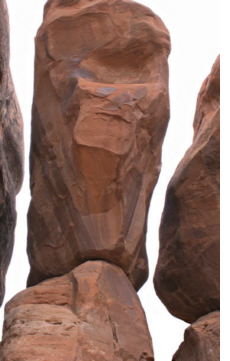 When I first showed these rock formations I’m calling Bones of the Earth, I was quite unsure what to do with them (I still am…). They seemed to invite a number of treatments. In particular, I found myself wishing I could paint them. Since I’d been admiring Sunil’s paintings of late, I naturally wondered how he might handle them: “Sunil, are you out there? Imagine these rocks as a weathered old face, what would you do with it?” I was not thinking that Sunil would actually see a face in them, but rather that considering the rock surface as skin might suggest coloring and brushwork that would give an interesting treatment. That was before my own musings on the power of face recognition. And if anyone has an over-developed fusiform gyrus in his brain, it’s Sunil (I can barely rotate 90 degrees, he easily does 180). Well, as you can guess, Sunil did see a face there — in fact three — and has recently posted on his blog the painting that resulted. It’s reproduced (with permission) below:
When I first showed these rock formations I’m calling Bones of the Earth, I was quite unsure what to do with them (I still am…). They seemed to invite a number of treatments. In particular, I found myself wishing I could paint them. Since I’d been admiring Sunil’s paintings of late, I naturally wondered how he might handle them: “Sunil, are you out there? Imagine these rocks as a weathered old face, what would you do with it?” I was not thinking that Sunil would actually see a face in them, but rather that considering the rock surface as skin might suggest coloring and brushwork that would give an interesting treatment. That was before my own musings on the power of face recognition. And if anyone has an over-developed fusiform gyrus in his brain, it’s Sunil (I can barely rotate 90 degrees, he easily does 180). Well, as you can guess, Sunil did see a face there — in fact three — and has recently posted on his blog the painting that resulted. It’s reproduced (with permission) below:
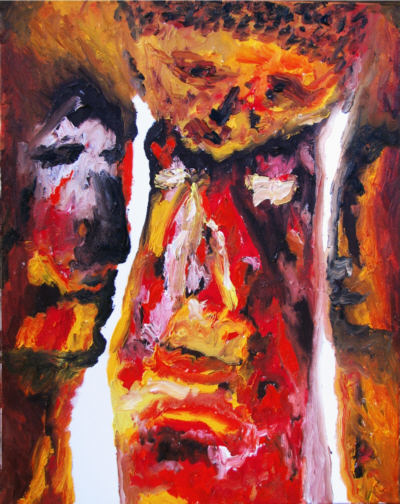
Sunil Gangadharan, Zephyrus, Cupid, and Psyche, 2007
A few months ago, in Orion magazine, I came across the article Fictitious Landscapes, in which the painter Peter Edlund presented his re-interpretations of some Ansel Adams photographs. I’m not comparing myself to Adams by any means, but I do think it would be fascinating to see Sunil’s versions of some of my photographs, whether transformed into faces or not. He (or anyone) is welcome to use anything he likes, but if the rocks appeal, some possibilities from the Bones of the Earth series are below. (Only a small portion of one of these may be intriguing, in which case I can easily provide an enlargement of that area.)
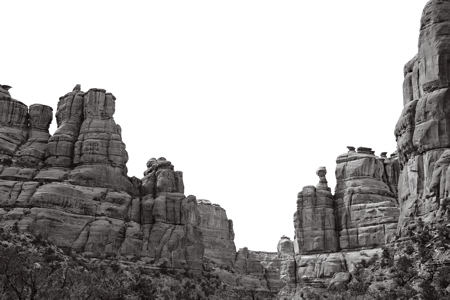
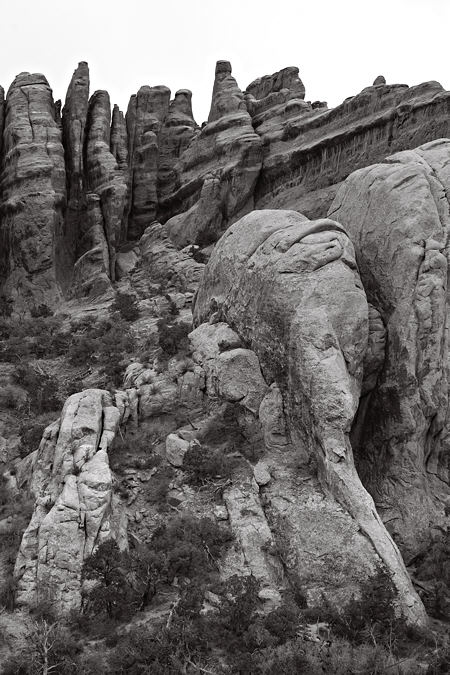
And this brings us to a question of perception that is close to my heart. Sunil’s original reactions were to a black and white photograph. Yet I sent him a color version to work from, thinking he might want to have an idea of the true rock color. But which, I wonder, makes a better spur to the imagination? Does a lack of color information keep the initial stimulus more vague, less real and specific, and hence open to more possibilities which the artist can select from? In this vein, I was struck that the sculptor in Karl’s recent post likes to start shaping faces with the smallest of hints, which she then develops bit by bit. That seems a natural approach to me, but it may not be for everyone. What would work best for you?
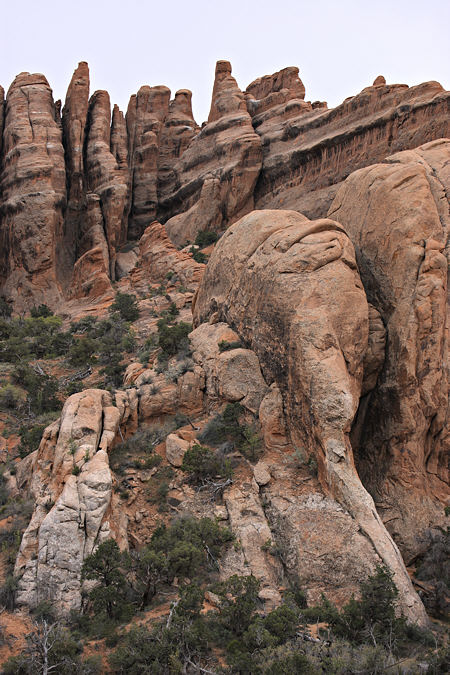
UPDATE: As promised, a larger version (1168×1752, 411KB) of the last image can be viewed or downloaded here. Feel free to do whatever you wish with any part of it. If there’s interest, we can have a gallery post to display the results.

What an interesting idea to use painting to develop faces off the rock formations. The last pictures crawls with faces. If I were a face painter, I would have tremendous fun playing with it.
Of course, as in abstract art, everyone will see something different. In the first picture, I see a lower half of a face with a prominent chin and mouth that is talking.
Steve,
Thanks for the kind words on the artworks and my fusiform gyrus ;-) . I love the picture of the rock face that you posted and plan on another experiment with this one in a short while. It will be great if I could have a higher res picture of the lower right half of the last picture. For some reason I prefer color rather than black/white…
Steve,
The eastern Oregon landscapes that I’ve been working with, particularly those from The Painted Hills (bright red and gold and green paleosols) are sometimes giant beasts, rolling up and through the earth, pushing it aside as they loll about or humping up out of the range land, backside first. Now the geologists will tell you it’s just clay, but I _know_ that these are creatures. And my paintings show them thus.
There are other creatures, particularly in some of the basalt rock “fans” that tend to drape over one another like large encrusted walruses. And sometimes just the prairie grass itself raises up and becomes alive — one of my little watercolors, Sleepy Giant, appeared in a painting that I did at dusk, when the world was drifting off into its first sleep.
Actually, I can see many faces in your rocks. And seeing them really is as the sculptor recounted — you find something like an eye or an ear or a mouth or a chin and that’s all it takes. Is there a word for this kind of imagining– not anthropomorphizing “mammalmorphizing?”
For example, look at the two grinning sly ones at the lower left of your last photo — something out of the Grimm brothers, perhaps, thinking evil thoughts about the foolishness of photographers…..
And I see a half dozen more, without even trying. This is better than clouds!
Steve/Sunil:
Painting reminds me of Elmer Bischoff and David Park. Good company.
The title though seems oddly serious for a playful exercise of “Upside-down Rock Formation.”
Steve:
Do you really mean to suggest that you are permitting us to save these images to our own computers, there to wreak whatever havoc our leering programs can conceive?
And would you want to see the carnage?
Jay: play away!
I’ll attach a higher resolution version to the bottom one when I have a chance in a few hours. Maybe we should have an A&P exclusive gallery show of the results?
Steve:
Get everyone involved – a group show. You could call it the “Rocky Horror Picture Show”. Perhaps you could give a short tutorial on how to transfer these files.
OK, the file is there; see UPDATE at the end of the post. You can either 1) click the link, view the image in your browser (it’s probably too large to see in full at highest resolution), and then Save it; or 2) right-click or otherwise select the link and do “Save link as …” or the analogous thing in your browser. The jpg file is not maximum resolution, but should be large enough for anything you want to do with it. You should be able to open it in almost any graphics program if desired.
Jay’s title for the show is appealing, but I don’t want to pre-judge the results by calling them horrors. So the floor is still open for a show title or any other suggestions.
I’ve received the first two entries in the Rock Faces contest. So far Jay carries away all honors — both entries are his. Get ready for a laugh:
I had been thinking of offering a prize to the winner (and all entrants), but I may have to rethink that…
Steve:
I missed this until now. You actually did it.
Waste of a good file I always say.
the ‘Elder’ says
Two hour after sunrise and two before sunset are the best time to capture the face in the rocks.
There is a old story that the are the first people.
Your angles are a tad off for the clarity of the view.
They say that most rocks will have a minumium of 144 faces.
that the you are see at that moment is the one talking to you.
If the face is looking at something that is the place to go look.
If the faces are lookig at each other the are in agreement.
Deborah,
What wonderful wisdom to pass along!